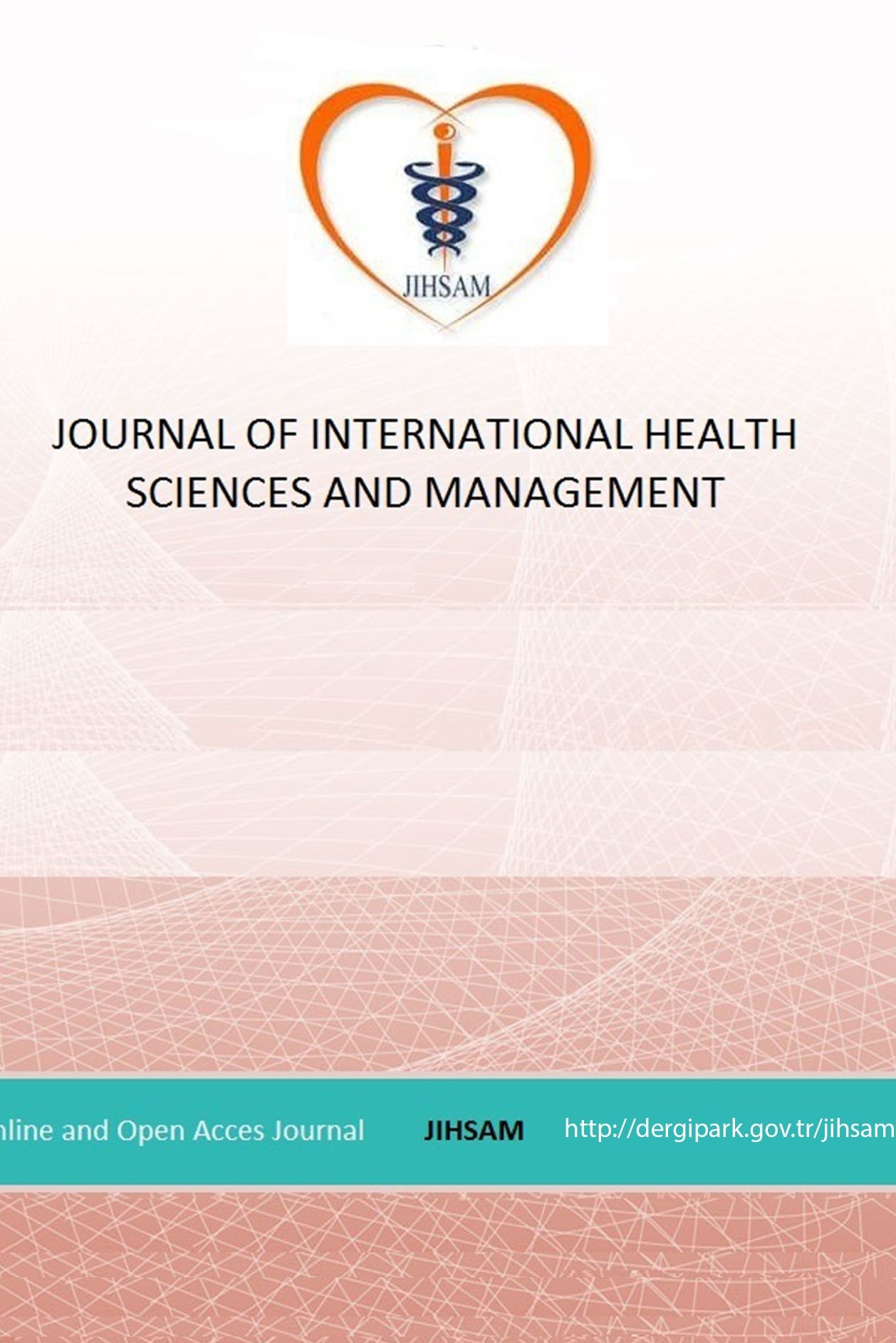The Mediating Role of Coaching Behavior in The Effects of Intrinsic Motivation on Work Addiction Among Nurses
The Mediating Role of Coaching Behavior in The Effects of Intrinsic Motivation on Work Addiction Among Nurses
İntrinsic motivation work addiction, coaching behavior,
___
- Abu Yahya, O., Ismaile, S., Allari, R. S., & Hammoudi, B. M. (2019). Correlates of nurses’ motivation and their demographic characteristics. Nursing forum,
- Ali, P. A. (2008). Professional development and the role of mentorship. Nursing standard, 22(42).
- Baron, R. M., & Kenny, D. A. (1986). The moderator–mediator variable distinction in social psychological research: Conceptual, strategic, and statistical considerations. Journal of personality and social psychology, 51(6), 1173.
- Bonebright, C. A. (2002). The relationship of workaholism with stress, burnout, and productivity [Dissertation Thesis, The University of Iowa]. USA.
- Buchan, J. (2010). Reviewing the benefits of health workforce stability. Human resources for health, 8(1), 29.
- Burke, R. J., Matthiesen, S. B., & Pallesen, S. (2006). Personality correlates of workaholism. Personality and Individual differences, 40(6), 1223-1233.
- Demerouti, E., & Bakker, A. B. (2011). The job demands-resources model: Challenges for future research. SA Journal of Industrial Psychology, 37(2), 01-09.
- Dundar, S., Ozutku, H., & Taspinar, F. (2007). Icsel ve dissal motivasyon araclarinin ısgorenlerin motivasyonu uzerindeki etkisi: Ampirik bir inceleme [The effects of intrinsic and extrinsic motivation tools on employees’ motivations: An empirical investigation]. Ticaret ve Turizm Egitim Fakultesi Dergisi, 2, 105-119.
- Ellinger, A. D., Ellinger, A. E., & Keller, S. B. (2003). Supervisory coaching behavior, employee satisfaction, and warehouse employee performance: A dyadic perspective in the distribution industry. Human resource development quarterly, 14(4), 435-458.
- Hammoudi, B. M., Ismaile, S., & Abu Yahya, O. (2018). Factors associated with medication administration errors and why nurses fail to report them. Scandinavian journal of caring sciences, 32(3), 1038-1046.
- Homer, J. B. (1985). Worker burnout: A dynamic model with implications for prevention and control. System Dynamics Review, 1(1), 42-62.
- Hugill, K., Sullivan, J., & Ezpeleta, M. L. (2018). Team coaching and rounding as a framework to enhance organizational wellbeing, & team performance. Journal of Neonatal Nursing, 24(3), 148-153.
- Jacobs, S. (2018). An analysis of the evolution of mentorship in nursing. International Journal of Mentoring and Coaching in Education.
- Kalkavan, S. (2014). Farklı Örgütsel Kültürlerde Yönetici Koçluk Davranışının Çalışanların İş Tatmini, Örgütsel Bağlılık ve Örgütsel Performans Algılarına Etkisi [Doctoral Dissertation, İstanbul Aydın University, Social Science Institute]. İstanbul, Turkey.
- Kanai, A., Wakabayashi, M., & Fling, S. (1996). Workaholism among employees in Japanese corporations: An examination based on the Japanese version of the Workaholism Scales. Japanese Psychological Research, 38(4), 192-203.
- Kubota, K., Shimazu, A., Kawakami, N., Takahashi, M., Nakata, A., & Schaufeli, W. B. (2010). Association between workaholism and sleep problems among hospital nurses. Industrial Health, 1006240015-1006240015.
- Manzi, A., Hirschhorn, L. R., Sherr, K., Chirwa, C., Baynes, C., & Awoonor-Williams, J. K. (2017). Mentorship and coaching to support strengthening healthcare systems: lessons learned across the five Population Health Implementation and Training partnership projects in sub-Saharan Africa. Bmc Health Services Research, 17(3), 831.
- Mau, A., Limbong, K., & Yetti, K. (2020). The effect of coaching and mentoring towards nurse's caring and patient satisfaction. Enfermería Clínica, 30, 18-22.
- Mottaz, C. J. (1985). The relative importance of intrinsic and extrinsic rewards as determinants of work satisfaction. The Sociological Quarterly, 26(3), 365-385.
- Quinones, C., & Griffiths, M. D. (2015). Addiction to work: A critical review of the workaholism construct and recommendations for assessment. Journal of Psychosocial Nursing and Mental Health Services, 53(10), 48-59.
- Ryan, R. M., & Deci, E. L. (2000). Intrinsic and extrinsic motivations: Classic definitions and new directions. Contemporary educational psychology, 25(1), 54-67.
- Saracel, N., Taşseven, Ö., & Ay, N. (2015). Örgütsel stresin iş motivasyonu üzerine etkisi: Banka çalışanları üzerine bir uygulama.
- Schaufeli, W. B., Taris, T. W., & Bakker, A. B. (2006). Dr. Jekyll or Mr. Hyde: On the differences between work engagement and workaholism. Research companion to working time and work addiction, 193-217.
- Shimazu, A., Schaufeli, W. B., & Taris, T. W. (2010). How does workaholism affect worker health and performance? The mediating role of coping. International journal of behavioral medicine, 17(2), 154-160.
- Spence, J. T., & Robbins, A. S. (1992). Workaholism: Definition, measurement, and preliminary results. Journal of personality assessment, 58(1), 160-178.
- van Beek, I., Hu, Q., Schaufeli, W. B., Taris, T. W., & Schreurs, B. H. (2012). For fun, love, or money: What drives workaholic, engaged, and burned‐out employees at work? Applied Psychology, 61(1), 30-55.
- Van den Broeck, A., Schreurs, B., De Witte, H., Vansteenkiste, M., Germeys, F., & Schaufeli, W. (2011). Understanding workaholics' motivations: A self‐determination perspective. Applied Psychology, 60(4), 600-621.
- Wang, E., Hu, H., Mao, S., & Liu, H. (2019). Intrinsic motivation and turnover intention among geriatric nurses employed in nursing homes: the roles of job burnout and pay satisfaction. Contemporary nurse, 55(2-3), 195-210.
- Yayın Aralığı: Yılda 2 Sayı
- Başlangıç: 2015
- Yayıncı: Sedat BOSTAN
EVALUATION OF THE RECOMMENDATIONS PART OF THESES IN THE FIELD OF HEALTH MANAGEMENT
Effect of health education about personal hygiene on student’s health in primary school
Amira BOSHRA, Abdalbasit MARIOD
Mustafa IŞIK, Onur YARAR, Didem SÖYLEMEZ SUR
Esendal GÜLEÇ, Kadriye SÖNMEZ, Suat PEKER, İbrahim Halil CANKUL
The Assessment of Turkey’s Lack of Resilience to Disasters and Hazards with IDB Indicator System
Ünal YAPRAK, Turgut ŞAHİNÖZ, Saime ŞAHİNÖZ
THE IMPACT OF PERCEIVED SOCIAL SUPPORT ON PERCEPTION OF HEALTH STATUS IN ISPARTA
ANALYSIS OF SOME CONCEPTS RELATED TO THE ENVIRONMENT AND HEALTH WITH THE N-GRAM METHOD
Ali ÇİFTÇİ, Alaaddin VURAL, Mustafa Nuri URAL
THE PERCEPTIONS OF NURSES ABOUT PATIENT SAFETY CULTURE: AN EXAMPLE PROVINCE IN NORTH EAST OF TURKEY
